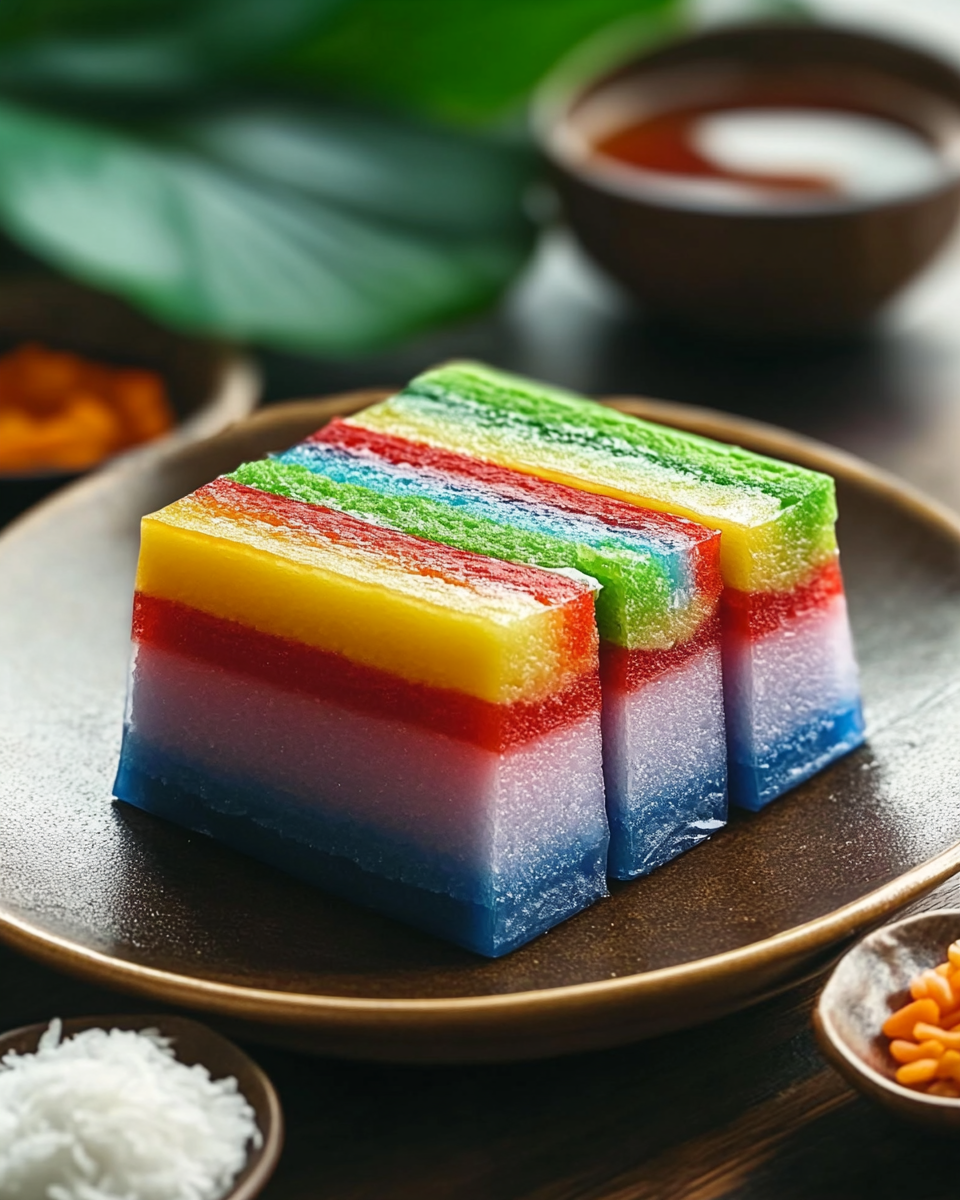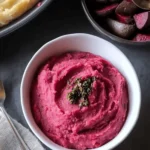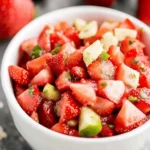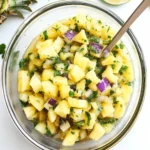A traditional Malaysian treat, Rainbow Kuih Lapis is a colorful, multi-layered steamed cake made with rice flour, coconut milk, and sugar. Each vibrant layer is a delicate combination of flavors and textures, making it a visually stunning dessert perfect for special occasions.
FULL RECIPE
Ingredients
- 200g rice flour
- 200g tapioca flour
- 500ml coconut milk
- 200g sugar
- 1/4 tsp salt
- 1 tsp pandan essence (for green layer)
- 1 tsp red food coloring (for red layer)
- 1 tsp yellow food coloring (for yellow layer)
- 1 tsp blue food coloring (for blue layer)
- 800ml water (for steaming)
Directions
- In a large mixing bowl, combine rice flour, tapioca flour, coconut milk, sugar, and salt. Stir until smooth and well combined.
- Divide the batter into separate bowls based on how many colors you want (typically four).
- Add a few drops of pandan essence to one bowl for a green layer.
- Add red food coloring to another bowl, yellow food coloring to the third, and blue food coloring to the fourth.
- Prepare a round or square steaming pan by lightly greasing it.
- Pour the first color of batter into the pan, then steam for 5–10 minutes, or until the layer sets.
- Once the first layer is set, pour the next color on top and steam again. Repeat the process for each color.
- Continue layering and steaming until all the batter is used up, ensuring each layer is fully steamed before adding the next.
- Once all layers are complete, allow the Kuih Lapis to cool completely before slicing into small squares or rectangles.
- Serve and enjoy your colorful treat!
Nutritional Information
- Calories: 120-150 per serving (based on a 1-inch square piece)
- Fat: 5g
- Carbohydrates: 20g
- Protein: 1g
- Fiber: 1g
- Sugar: 12g
History and Origin of Rainbow Kuih Lapis
Rainbow Kuih Lapis is a well-loved dessert that traces its roots back to Southeast Asia, specifically Malaysia and Indonesia. Known for its vibrant layers, this steamed cake has been a part of local culture for generations. The name “Kuih Lapis” literally means “layered cake” in Malay, and it’s fitting as the dessert showcases multiple layers made with rice flour, coconut milk, and sugar. It’s often made during special events, particularly festivals, where its colorful layers symbolize prosperity and happiness. The recipe has evolved over time, with modern versions adding unique flavors and ingredients, but the original concept of layering remains an iconic part of its charm.
Significance of Color in Kuih Lapis
Color plays a symbolic role in Rainbow Kuih Lapis, as each hue carries its own meaning. Traditionally, the green layer, which is flavored with pandan essence, represents freshness and vitality. The red layer stands for luck and good fortune, while yellow conveys wealth and success. The blue layer, though less common, adds a sense of calm and peace to the dessert. These colors are not only aesthetically pleasing but also reflect the cultural importance of symbolism in Southeast Asian cuisine. The practice of using natural ingredients for coloring further connects the dessert to traditional food-making methods.
The Role of Coconut Milk in the Recipe
Coconut milk is one of the defining ingredients in Rainbow Kuih Lapis, contributing to the cake’s richness and smooth texture. It imparts a naturally creamy flavor that balances out the sweetness of the sugar. In addition to enhancing the taste, coconut milk is a staple in Southeast Asian cooking, known for its health benefits. Rich in healthy fats, vitamins, and antioxidants, it elevates the dish and gives it a luxurious feel. The natural sweetness of coconut milk complements the other ingredients, allowing the layers of the kuih lapis to meld together beautifully.
Steaming as the Preferred Cooking Method
Steaming is the traditional method used to cook Rainbow Kuih Lapis, and it’s what gives the cake its characteristic texture. The gentle heat of steaming helps preserve the flavors of the coconut milk while ensuring the layers remain distinct and vibrant. It also retains the moisture of the cake, keeping each layer soft and tender. Steaming also has the advantage of being a healthy cooking method, as it preserves the nutrients in the ingredients without using excessive oil or fats. This technique also plays a key role in ensuring that the color of each layer stays intact, adding to the cake’s visual appeal.
Variations of Rainbow Kuih Lapis
While the traditional Rainbow Kuih Lapis follows a set recipe, there are many regional variations that bring in different ingredients and flavors. Some recipes use mung bean flour or cornflour instead of rice flour, giving the cake a slightly different texture. Others may use natural food colorings, such as beetroot for red or butterfly pea flower for blue, instead of artificial dyes. These variations allow for personalization, catering to different taste preferences while still maintaining the essence of the traditional layered cake. The versatility of the recipe makes it a popular choice for modern chefs who enjoy experimenting with flavors and ingredients.
The Symbolism of Layering in Kuih Lapis
The process of layering in Rainbow Kuih Lapis is far more than just an aesthetic choice. Each layer is a metaphor for the stages of life, representing how each experience builds upon the previous one. The careful addition of each layer speaks to the patience and precision required to create the perfect cake. In a broader sense, the layers also symbolize unity and harmony, with each layer contributing to the whole. This layering technique also reflects the craftsmanship and skill involved in making this dessert, adding a deeper layer of meaning to the dish.
How Rainbow Kuih Lapis is Served
Rainbow Kuih Lapis is typically served in small, bite-sized squares or rectangles. This makes it easy to share, making it a great choice for celebrations and gatherings. It pairs beautifully with hot tea or coffee, which helps balance out the cake’s richness. In Malaysia and Indonesia, the kuih lapis is often served during festive occasions such as weddings, Hari Raya, and Chinese New Year. Its vibrant colors and intricate design make it a showstopper at any event, symbolizing happiness and good fortune.
The Importance of Presentation
Presentation plays an important role in showcasing Rainbow Kuih Lapis. The cake’s multi-layered design is what makes it stand out, and each slice should reveal the distinct colors. The layers should be smooth, even, and free of any air pockets, ensuring that the cake looks as beautiful as it tastes. Careful attention to detail when arranging the slices on a plate further enhances the dish’s appeal. Serving Rainbow Kuih Lapis on a traditional serving dish or in a woven basket adds to the cultural significance and presentation, making it not only a treat for the palate but also for the eyes.
Challenges in Making Rainbow Kuih Lapis
While making Rainbow Kuih Lapis is a rewarding process, it comes with its own set of challenges. One of the biggest hurdles is ensuring that each layer is properly steamed before adding the next. If the previous layer isn’t cooked enough, the layers will not stay distinct and may blend together. Timing is crucial, and it takes practice to get it right. The layering technique also requires precision; each layer must be poured evenly, with no bubbles or unevenness. The use of food coloring also requires care, as too much dye can overwhelm the flavor, while too little may result in pale colors.
Cultural Significance of Kuih Lapis
Rainbow Kuih Lapis holds great cultural significance in Southeast Asia. It is a common dessert during important celebrations, symbolizing prosperity, happiness, and family unity. In Malaysia, kuih lapis is especially popular during the Muslim holiday of Hari Raya, which marks the end of Ramadan. It is also frequently enjoyed during Chinese New Year, where its colorful layers are seen as an omen for a prosperous year ahead. The preparation of this dessert is often a family affair, with generations passing down their secret recipes and techniques.
Rainbow Kuih Lapis and Festive Occasions
Rainbow Kuih Lapis is typically reserved for special occasions, and its vibrant colors make it a perfect addition to any festive spread. The layers represent the joy and prosperity that these occasions bring. During Hari Raya, kuih lapis is often served alongside other traditional Malaysian sweets, creating a festive atmosphere that celebrates both food and culture. Similarly, during Chinese New Year, the colorful dessert is enjoyed as a symbol of good luck and fortune for the coming year. Whether served at weddings, family gatherings, or religious holidays, Rainbow Kuih Lapis always adds a touch of elegance and meaning to the celebration.
Rainbow Kuih Lapis in Modern Times
In the modern culinary landscape, Rainbow Kuih Lapis has undergone some transformations. With the rise of food bloggers, home bakers, and chefs, the dessert has gained global recognition. Many have experimented with adding unique flavors like matcha, chocolate, or even durian to the cake, while also using natural food colorings to create a more health-conscious version. Despite these variations, the essence of the traditional recipe remains. This adaptability has helped Rainbow Kuih Lapis maintain its place in both traditional and contemporary kitchens, making it a beloved dessert worldwide.
The Health Benefits of Coconut Milk
Coconut milk, one of the primary ingredients in Rainbow Kuih Lapis, offers numerous health benefits. It is rich in medium-chain triglycerides (MCTs), which are healthy fats that can help boost metabolism and support brain function. Coconut milk also contains essential vitamins and minerals like magnesium, potassium, and iron, which contribute to overall health. While coconut milk is high in fat, the fats it contains are considered to be beneficial for heart health. Including coconut milk in desserts like Rainbow Kuih Lapis provides a delicious way to enjoy these health benefits in moderation.
Rainbow Kuih Lapis for Special Diets
Rainbow Kuih Lapis can be adapted to suit a variety of dietary needs. For those who need a gluten-free option, the recipe can be modified by ensuring that all ingredients are certified gluten-free. The use of rice flour and tapioca flour already makes this dessert a good choice for those avoiding gluten. Additionally, for individuals following a dairy-free or vegan diet, the recipe can easily be made by using coconut milk, which is already a suitable dairy substitute. These adjustments make Rainbow Kuih Lapis a versatile treat that can be enjoyed by many, regardless of dietary restrictions.
Storage and Shelf Life of Rainbow Kuih Lapis
Rainbow Kuih Lapis can be stored in an airtight container to keep it fresh. Ideally, it should be consumed within a few days of being made, as the cake is at its best when freshly prepared. The texture tends to change over time, becoming firmer when refrigerated. However, the vibrant colors and delicate layers may lose some of their appeal if stored for too long. If you need to keep it for a longer period, Rainbow Kuih Lapis can be refrigerated for up to a week. Just remember to let it return to room temperature before serving for the best texture and flavor.
Rainbow Kuih Lapis as a Gift
Rainbow Kuih Lapis makes an excellent gift, especially for special occasions. Its colorful layers and intricate design are sure to impress anyone who receives it. Giving kuih lapis as a gift shows thoughtfulness and care, as it is a labor-intensive dessert that requires patience and skill to create. Whether wrapped in a decorative box or placed in a traditional woven basket, the kuih lapis will be appreciated not only for its taste but also for its cultural significance. Gifting this dessert is a way of sharing both food and tradition with loved ones.
Advertisement
Pairing Rainbow Kuih Lapis with Beverages
Rainbow Kuih Lapis pairs beautifully with a wide range of beverages. It is traditionally served with a cup of tea, whether it’s a hot, fragrant jasmine tea or a cup of robust black tea. The richness of the kuih lapis contrasts nicely with the light, refreshing qualities of tea. Alternatively, it can be enjoyed with coffee, which complements the coconut milk’s creaminess. For a lighter option, a glass of coconut water or a chilled iced tea can be the perfect pairing, helping to balance out the dessert’s sweetness.
The Craftsmanship Behind Rainbow Kuih Lapis
Making Rainbow Kuih Lapis requires considerable skill and attention to detail. Each layer must be poured carefully, ensuring even distribution and a smooth finish. The timing of each steaming session is crucial to achieve the perfect texture for every layer. The layers should be thin and delicate, with no bubbles or inconsistencies. The artistry of the dish lies in the balance between the layers, as well as in the creation of vibrant colors that remain distinct after steaming. The craftsmanship involved in making Rainbow Kuih Lapis is a reflection of the cook’s expertise and passion for traditional desserts.
Conclusion
Rainbow Kuih Lapis is much more than a dessert; it’s a symbol of tradition, culture, and celebration. The combination of colorful layers, coconut milk, and delicate flavors makes it a beloved treat in Southeast Asia and beyond. Its rich history and cultural significance continue to be passed down through generations, making it a timeless dessert. Whether you’re enjoying it during a festive occasion or gifting it to a loved one, Rainbow Kuih Lapis brings joy and sweetness to any gathering. This traditional dessert stands as a testament to the beauty and artistry of Southeast Asian cuisine.






